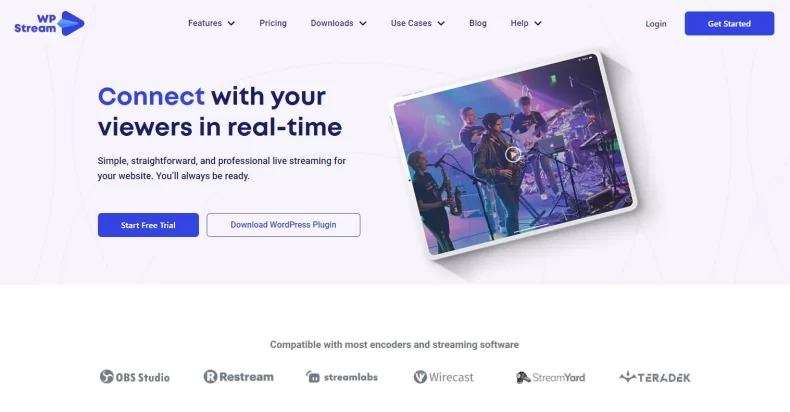Last modified: September 23, 2024
It’s no secret that live streaming is a great way of reaching a larger audience and interacting with them in real time, but those aren’t the only benefits – with a little know-how, live broadcasting may also be a lucrative source of income.
If you choose the right streaming platform, there are many ways to make money from live-streamed content. Whether you are broadcasting live events and want to charge for attendance or are looking to bring in extra income through subscription fees or donations, there are many options for monetizing live-streamed content.
Here, we will look at the different ways that you can make money by live streaming, as well as the best live streaming solutions on the market for monetizing your live video content.

How do you monetize live streaming?
There are many different ways that you can monetize your live stream in order to generate a revenue stream from your video content, whatever industry you are in. Let’s take a look at a few of the most popular ways of doing it:
Pay-per-view live streams
The simplest way to make money live streaming is to use a pay-per-view strategy. This places your stream material behind a paywall, requiring users to pay a fee to access it.
Many content creators use pay-per-view when live-streaming ticketed events. If, for example, you were live-streaming a conference that you charged a fee to attend, you could set up a pay-per-view stream to enable people to participate remotely.
Some streamers also like to record their streams and make them available later as video-on-demand (VOD) content. By making this VOD content available on a pay-per-view basis, viewers can watch at their convenience, making the content more accessible while also generating extra revenue for the streamer.
Memberships
Making special content available only to subscribers is another simple method for streamers to monetize their live streams.
Some broadcasters will use a membership model for all of their video content, while others will provide free streaming to the public while charging a fee for exclusive members-only material.
Some live streaming services have support for memberships built in, while others add this feature by integrating with third-party platforms. Patreon is perhaps the best-known example of a membership program that streamers use on many different platforms. It enables streamers to set up different levels of membership, with different benefits for each level.
Donations
Accepting donations from viewers is a big way for many streamers to make money from their live broadcasts. Donation-based monetization strategies are supported by many of the most popular live video streaming platforms.
Examples include Facebook Live’s “Stars” system, YouTube Live’s “Super Chat” and “Super Likes” systems, Twitch’s “Bits” system, and TikTok’s “Diamonds” system. These work by enabling viewers to donate a form of in-platform currency to their favorite streamers, which is then converted to real money.
Sponsorship and advertising
One of the most prevalent revenue techniques utilized by streamers is advertising. Streamers can earn money through advertising in a variety of ways, including:
- Using third-party advertisements during streams in exchange for a percentage of the revenue collected.
- Running sponsored streams, in which the streamer promotes a product or service in exchange for sponsorship. Creators who do this regularly are often called ‘influencers’.
- Adding overlays and branding to their streams promoting a particular product, service, or business, in exchange for a fee or a part of the revenue produced.
Merchandise
As we have seen, live streaming may be an effective form of advertising, but it does not have to be confined to third-party goods and services. Popular streamers might use their live broadcasts to market their own products and merchandise.
Some live streaming platforms integrate directly with sales platforms, making it easier for streamers to make money through the sale of merchandise. For streamers who stream via their own website, it is even easier to advertise and sell your products. For example, if you stream through WordPress using a streaming platform like WpStream, you could easily sell merchandise through your website through integration with WooCommerce.
What are the best platforms for making money from live streaming?
When it comes to choosing the best live streaming platform for monetizing your stream, there are two primary categories of platforms you’ll want to be aware of, each with its own set of advantages and disadvantages:
Social media platforms
As the name implies, these live-streaming services are usually linked to large social media platforms. A major advantage of this is that these platforms already have huge built-in audiences, which makes it much easier for streamers to build a following.
These platforms also have the advantage of being simple to use and, in most cases, free. Most social networking networks also include built-in monetization strategies, which makes it easy to get started making money from your streams without the need for any technical setup.
The downside of using a social media streaming platform is that you will have reduced control over the content of your stream. Most social media platforms don’t let you remove their business branding, and many also have strict guidelines regarding the type of content you can post. This makes them unsuitable for some types of content creators.
Another disadvantage of social media platforms is they offer little control over how your content is monetized. While having built-in support for some monetization models might at first seem like an upside, the caveat is that most social media platforms can’t be extended through external integrations to support additional monetization strategies.
On top of this, there are usually strict rules about what content can and can’t be monetized, and many social media platforms require streamers to fulfill certain criteria before they can start monetizing their content. For example, YouTube Live requires streamers to have at least 1,000 subscribers and 4,000 valid watch hours in the last 12 months for content to be able to be monetized.
With those advantages and drawbacks in mind, let’s take a look at some of the most popular social media streaming platforms available, and what they offer in terms of content monetization:
YouTube Live
YouTube is one of the best-known platforms offering a live streaming service, with over 2 billion monthly active users. The ability to live stream via YouTube was added to the popular video platform in 2011.
As we briefly touched on earlier, the ‘Super Chat’ and ‘Super Likes’ systems are two methods for monetizing your channel on YouTube Live, with the ‘Super Chat’ system enabling stream viewers to purchase standout chat messages and pin them to the top of a conversation feed. Other monetization strategies supported by the platform include ad revenue and the ability to sell merchandise directly from your YouTube channel.
Facebook Live
Facebook is the most popular social media platform, with 2.9 billion monthly active users, making Facebook Live a great choice of platform if your main goal with your stream content is to attract a following.
The ‘Stars’ system is one way that streamers can monetize their video output. Viewers can purchase Stars and send them to you in the comment area to show their appreciation and make their message stand out. You are awarded one cent for each Star you obtain. Aside from this, streamers can make money through advertising and a paid subscription system.
Twitch
Twitch is best known as being a popular streaming platform for gamers and eSports enthusiasts, among other things, and is generally more flexible than other free platforms in terms of branding.
There are different overarching monetization models available on Twitch:
- Twitch Affiliate: In order to become an affiliate, you must have at least 50 followers and achieve certain streaming metrics in the last 30 days (500 minutes broadcast over at least seven unique days with an average of at least three concurrent viewers). As an affiliate, you can make money through Twitch’s ‘Bits’ system (similar to Facebook’s ‘Stars’ system), ad revenue, or subscriptions.
- Twitch Partner: To become a Twitch Partner, you need a big jump in your 30-day metrics, such as streaming 25 hours over at least 12 days with an average of 75 people watching at the same time. Once you have met these requirements, you can apply to become a partner. Twitch Partners earn money in the same ways as affiliates but take a larger percentage of the revenue from each source.
Professional live-streaming platforms
Professional live-streaming services differ from social media streaming platforms in how they typically charge a one-time or monthly subscription fee. In return for this additional cost, you’ll get a platform that is more customizable, flexible, and scalable than most social media live-streaming services.
The best thing about professional streaming platforms is that they give you a lot of control over what you stream and how you make money from it. The best professional platforms offer all the main monetization models and make it simple to monetize your stream content.
If you want complete control over how your stream content, including branding aspects, revenue strategies, and the overall look and feel of your stream, the best approach is to choose a professional streaming platform that allows you to host your stream content directly on your own website.
One such platform is WpStream, a WordPress plugin that allows you to stream straight to your WordPress website without the need for any third-party infrastructure. Let’s take a look at some of the features that make WpStream a great platform for monetizing your stream content:
- Support for all of the most popular forms of monetization – WpStream, which was developed specifically for WordPress, provides support for a wide variety of monetization models thanks to its interaction with WooCommerce. You can easily sell merchandise directly on your own website, in addition to providing pay-per-view streams, a subscription model (through WooCommerce Subscriptions), and the ability to receive donations (with GiveWP).
- Total control over your stream content and appearance – As a white-label platform, WpStream enables you to incorporate any branding or advertising that you choose into your stream. In addition, because the content of your stream is hosted on your own WordPress website, you do not need to worry about complying with stringent restrictions for the monetization of content. As you have total control over your stream content, you can still host sponsored streams or run advertisements as you wish, the difference being that you will have full control over how these are presented.
- Compatibility with multistreaming tools – WpStream is compatible with all major multistreaming platforms and tools that support an RTMP connection. This makes it possible for you to broadcast to a number of different streaming platforms simultaneously, in addition to your WordPress website. As a result, you will be able to maximize your earning potential by reaching a larger audience.

Maximize your streaming revenue potential with WpStream
Live streaming is not only a fantastic way to reach a larger audience, but it can also be a good source of revenue, and there are a number of different options available for monetizing your broadcast.
If you want to maximize the revenue potential from monetizing your live video content, WpStream is the best choice. It supports a range of monetization strategies, gives you complete control over the way your stream looks and what you can stream, and is compatible with a range of multistreaming tools to enable you to reach a large audience and further increase your earning potential.
WpStream is suitable for all creators of live video content, regardless of your streaming setup – all you need to get started is a WordPress website, the WpStream plugin, and a laptop or mobile device. You can even take advantage of a free trial to test out all of the plugin’s features. Then, once you’re sure WpStream is a great fit for your stream, check out the pricing calculator to find the perfect plan for your requirements.
Table of Content







